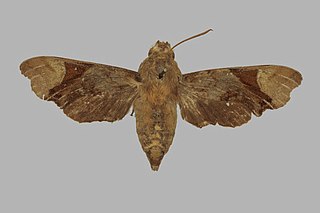
Temnora fumosa is a moth of the family Sphingidae. It is found in most habitats throughout Africa south of the Sahara.

Temnora argyropeza is a moth of the family Sphingidae. It is known from Madagascar.

Temnora marginata is a moth of the family Sphingidae first described by Francis Walker in 1856. It is known from savannah and woodland in eastern and southern Africa.

Temnora reutlingeri is a moth of the family Sphingidae. It is known from Nigeria to Gabon.

Temnora griseata is a moth of the family Sphingidae. It is known from forests from Nigeria to southern Congo, southern Tanzania and Malawi.

Temnora engis is a moth of the family Sphingidae. It is known from Madagascar.

Temnora inornatum is a moth of the family Sphingidae. It is known from South Africa.

Temnora namaqua is a moth of the family Sphingidae. It is known from South Africa to Tanzania.

Temnora elegans is a moth of the family Sphingidae. It is known from western Africa and in savanna from Angola to Zambia, Zimbabwe, Malawi and East Africa.

Temnora sardanus is a moth of the family Sphingidae. It is known from forests and heavy woodland from Sierra Leone to Congo and Angola, then to Zimbabwe and East Africa.

Temnora avinoffi is a moth of the family Sphingidae. It is known from Nigeria to Cameroon and Gabon.

Temnora crenulata is a moth of the family Sphingidae. It is known from forests from Sierra Leone to Congo, Uganda and western Kenya, with an isolated population in the Usambara Mountains of north-eastern Tanzania.

Temnora radiata is a moth of the family Sphingidae. It is found from West Africa to Angola.

Temnora plagiata is a moth of the family Sphingidae. It is found in Africa.

Temnora spiritus is a moth of the family Sphingidae. It is known from forests from Sierra Leone to Congo, Uganda, and western Kenya.
Temnora hollandi is a moth of the family Sphingidae. It is known from forests from Nigeria to Congo and Uganda.

Temnora rattrayi is a moth of the family Sphingidae. It is known from forests in Congo and Uganda.

Temnora zantus is a moth of the family Sphingidae. It is known from forests in Congo and Uganda.

Temnora pseudopylas is a moth of the family Sphingidae. It is very common in eastern and southern Africa, but absent in very dry habitats.

Temnora pylades is a moth of the family Sphingidae. It is known from Uganda, Kenya, Tanzania and Malawi.



















